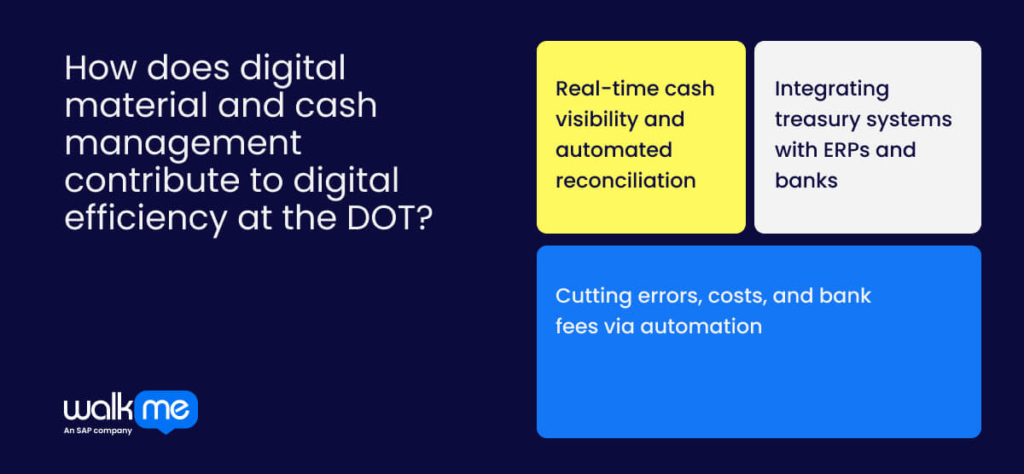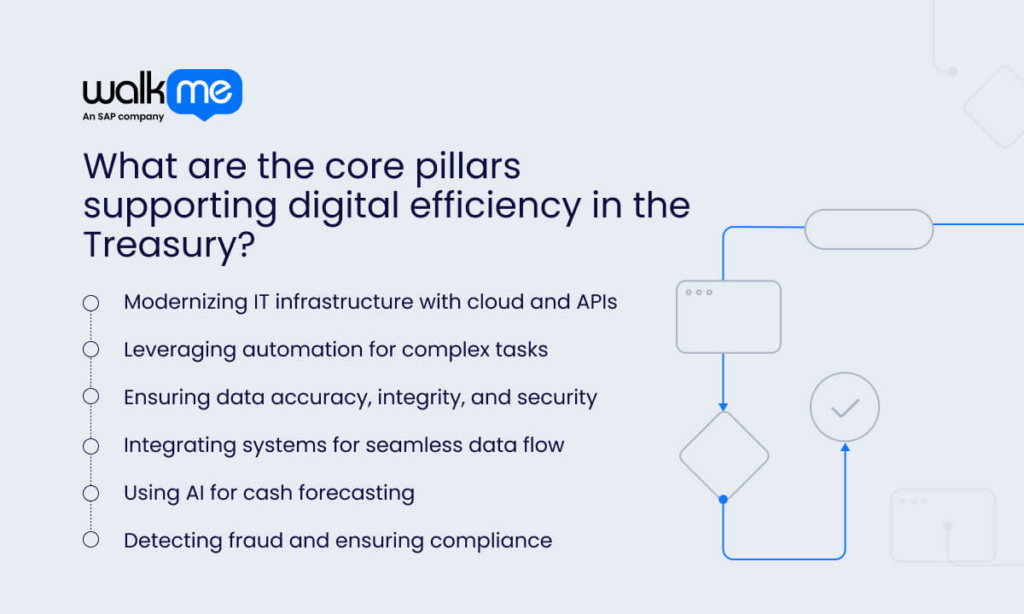The U.S. Department of the Treasury (DOT) is one of the most important government agencies. It manages federal finances that support all other departments and oversees monetary policy, with effects that reach far beyond the United States.
The Treasury has steadily invested in digital efficiency for years. Recent advances in technologies like AI-driven compliance and fintech innovations, including blockchain reporting, mean these efforts must continue strongly.
Digital efficiency here means modernizing systems and processes to handle complex financial data more effectively.
Staying ahead of these developments is essential for maintaining oversight and ensuring the financial system functions reliably worldwide.
This article explores digital efficiency in the U.S. Department of the Treasury.
What is digital efficiency in the Department of the Treasury?
Digital efficiency at the U.S. Department of the Treasury involves utilizing modern technology to streamline financial processes, making them faster, simpler, and more secure.
It replaces slow, paper-based processes with automation technology that reduces errors and helps manage finances more effectively.
One example is the Treasury’s Invoice Processing Platform (IPP), which moves payment approvals online. A recent report shows that using IPP has already reduced the cost of processing undisputed invoices by 54% and disputed invoices by 43%.
This all means invoices get paid faster, and staff spend less time on paperwork. It also saves millions of dollars by lowering costs tied to manual handling.
Using tools like this helps the Treasury handle billions in government payments by freeing up staff to focus on more important tasks and improving how the government manages its resources.
Why is digital efficiency important in the Department of the Treasury?
Digital efficiency is vital for the U.S. Department of the Treasury because it manages trillions in government funds annually, requiring precision and speed.
In 2023, the Treasury handled over $6.6 trillion in tax collections and disbursed nearly $7 trillion in payments. Managing such volumes demands technology that reduces delays and errors while ensuring security.
Without efficient systems, processing these transactions would take longer and risk costly mistakes. For instance, automating tax processing reduces manual reviews, speeds up refunds, and lowers the risk of fraud.
In 2024, the Treasury’s Office of Payment Integrity used smart technology like machine learning (ML) to recover over $4 billion lost to fraud and errors. This is significantly more than the $652.7 million retrieved in the previous year. It also shows how digital tools are helping the Treasury manage money more competently.
Faster data processing also allows the Treasury to respond to economic changes quickly, such as during stimulus payments or emergency funding.
Digital efficiency supports accountability and transparency, letting the Treasury closely monitor funds. It safeguards taxpayer money and ensures that government financial operations run reliably under pressure.
Why is digital efficiency critical to the Treasury’s mission and outcomes?
Digital efficiency isn’t just a technical upgrade; it directly shapes how the Treasury manages risk, resources, and public trust. To grasp the full scope of its work, it’s important to see how technology underpins every financial decision the department makes.
Let’s take a closer look at why digital efficiency is critical to the Treasury’s mission and outcomes:
Improving cash forecasting and risk management accuracy
The Treasury handles billions of dollars, from tax refunds to debt payments. To keep operations steady, it must accurately predict how much cash is needed and when. Digital tools help by giving up-to-date views of balances and payment patterns.
That means staff no longer rely on outdated estimates or manual calculations. They can adjust plans as conditions change, like during market shifts or natural disasters. More accurate forecasts reduce the chance of running short or holding excess cash that could be put to better use. It’s a smarter way to manage risk, built into everyday financial decisions.
Addressing legacy systems and manual workflow challenges
Some of the Treasury’s old platforms were built decades ago. They weren’t designed to handle the speed or complexity of today’s federal transactions. In the past, teams had to re-enter the same data across multiple systems, often by hand.
Newer tools replace those outdated steps with automated checks, shared databases, and real-time updates. This shift cuts the back-and-forth, lowers the risk of mistakes, and gives staff time to focus on more important assignments. It also prepares the department to adapt faster when programs change or new funding laws take effect.
Boosting decision speed and operational reliability
The Treasury uses digital dashboards to track real-time data on debt levels, incoming tax receipts, and outgoing payments. During market disruptions or economic emergencies, this visibility helped teams adjust borrowing schedules within hours. Instead of relying on static spreadsheets or delayed reports, staff now see what’s happening as it unfolds.
Automated alerts also flag unexpected trends, such as sudden changes in revenue flow. That means fewer surprises and faster responses. When systems are up to date, Treasury decisions are quicker, better informed, and less likely to cause knock-on delays elsewhere.
How does digital material and cash management contribute to digital efficiency at the DOT?

Understanding how the Treasury manages both digital assets and physical cash reveals the full scope of its efficiency efforts. This insight helps show how the department balances traditional finance with modern technology to meet complex demands.
Let’s take a closer look:
Real-time cash visibility and automated reconciliation
The Treasury tracks daily cash flows through centralized systems linked to federal accounts. Staff no longer wait days to confirm balance and can now monitor transactions as they occur. Incoming and outgoing payments are matched automatically with internal records. If something doesn’t line up, the system flags it for review.
This helps avoid missed payments and manual corrections. It’s especially important for time-sensitive programs, such as benefit disbursements or debt servicing. Real-time visibility also improves forecasting, helping the department plan large transfers while reducing the risk of error or overspending.
Integrating treasury systems with ERPs and banks
Treasury systems are connected directly to bank networks and enterprise resource planning (ERP) platforms using Fedwire and ISO 20022 messaging standards.
This setup ensures payments and account updates appear instantly across all systems, removing the need for duplicate data entry. As a result, error rates drop, compliance improves, and staff can rely on consistent transaction data. It also makes managing government funds more accurate and secure.
Cutting errors, costs, and bank fees via automation
The Treasury’s Do Not Pay system checks vendors and individuals against improper-payment databases before issuing any funds. Automated match checks also help prevent overpayments and fraud.
The Central Accounting Reporting System (CARS) automatically records transactions in budget accounts after bills are paid, thereby reducing the need for manual entries. Switching from paper checks to electronic payments also cuts printing, postage, and bank fees. These tools, combined, save millions of dollars annually and boost accuracy, saving taxpayer money and strengthening financial oversight.
What are the core pillars supporting digital efficiency in the Treasury?

Now that we’ve reached the core pillars, you should understand what digital efficiency at the Treasury truly means, why it matters deeply, and how it supports the department’s mission to manage the nation’s finances.
The core pillars will help you develop a clear picture of how digital efficiency drives better financial management within the Treasury.
Let’s take a closer look:
Modernizing IT infrastructure with cloud and APIs
The Treasury is using the cloud to migrate legacy systems to cloud platforms that adjust to changing demands. Cloud computing reduces costs and speeds up updates. Open APIs enable different financial programs to communicate with each other instantly. This setup allows staff to securely access data from anywhere, supporting faster responses and more flexible operations.
Leveraging automation for complex tasks
Automation processes millions of federal payments by cross-checking invoices with contract terms without human intervention. For instance, automated workflows flag mismatches in grant funding, accelerating approvals. This approach cuts processing time from weeks to days and frees staff to focus on oversight and risk assessment.
Ensuring data accuracy, integrity, and security
Treasury’s encryption protocols protect sensitive taxpayer and financial data during transfer and storage. Role-based access controls limit who can view or change records, preventing internal misuse. Continuous audit logs track every transaction and system change, allowing rapid investigation if irregularities appear. These safeguards uphold the integrity of federal financial reporting and build confidence among lawmakers and the public.
Integrating systems for seamless data flow
Payments, debt management, and accounting systems are closely integrated, allowing for instant updates across all platforms. When Treasury issues a bond, linked systems automatically update related cash balances and compliance reports. This integration removes repetitive manual entries and shortens month-end closing times. Real-time data flow enables coordinated action between Treasury bureaus and external partners, such as the Federal Reserve.
Using AI for cash forecasting
AI models analyze historic tax receipts, spending trends, and economic indicators to refine cash flow predictions daily. It identifies anomalies such as unexpected revenue dips, prompting faster adjustments in borrowing strategies. This level of forecasting accuracy helps the Treasury avoid costly cash shortages or surpluses, improving overall financial stability during uncertain economic conditions.
Detecting fraud and ensuring compliance
The Treasury deploys analytics engines that scan millions of transactions for patterns linked to fraud, like repeated vendor payments or unusual invoice amounts. Suspicious cases trigger automatic holds pending review. Compliance checks ensure funds adhere to federal rules, preventing improper payments before disbursal. Automated fraud detection has saved billions and strengthened public trust by safeguarding taxpayer dollars.
What future developments will shape digital efficiency at the DOT?
As the Treasury provides finances and resources to all other departments, it must be especially careful in managing its own funds.
This is even more important now, as new fintech solutions, such as real-time payment networks, are starting to disrupt financial markets.
A proactive approach to efficiency, innovation, and digital adoption is necessary to build a strong foundation for the future.
With the rise of AI, growing fraud risks, and digital efficiency savings seen across the department, the Treasury must stay extra vigilant.
Keeping up with technology changes and maintaining careful oversight will help protect taxpayer dollars and ensure the department can meet its critical mission.
FAQs
Digital tools expedite tasks like checking payment details and matching bills to records. This helps catch mistakes early and saves money. Using cloud systems cuts costs for running and fixing old computers. These changes enable the Treasury to handle large financial workloads more efficiently and accurately, without the need to hire additional personnel.
Automation takes over simple, repetitive work like comparing numbers and making reports. This lowers errors and lets employees spend time on more important projects. Because routine tasks are completed more efficiently, the Treasury can process more with the same staff.
Having live updates on financial data out helps Treasury staff act quickly. They can spot unusual changes and adjust procedures before problems develop. Real-time information means better choices for managing government funds and avoiding costly delays.
Updating legacy technology without slowing down the pace of work is a challenging task. New systems must fit with the old ones, which takes careful setup. Staff need training to use the latest tools correctly. This can slow progress, but it is necessary for lasting change.

